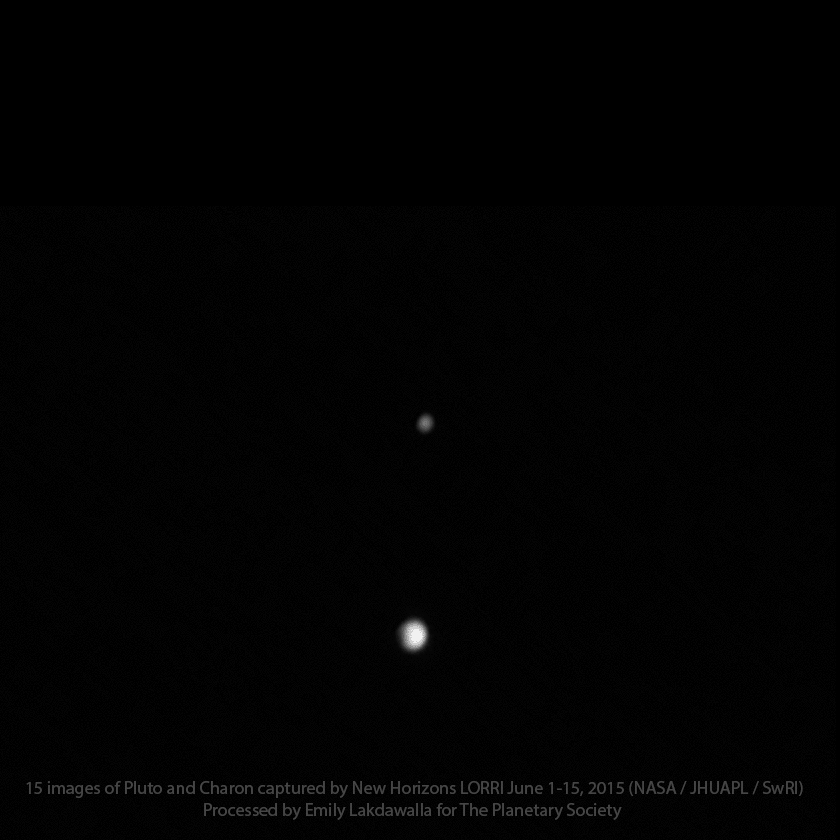Emily Lakdawalla • Jun 16, 2015
Pluto and Charon spin among the stars
I've spent a happy couple of days playing with raw data downloaded from the New Horizons website. Before I wander into lengthy descriptions of what you can and can't do with these photos, I thought I'd share the result of my work. This animation consists of images of Pluto and Charon and background stars taken between June 1 and June 15. For this animation, I chose to align things on background stars. That makes Pluto and Charon whirl and dance about their mutual barycenter, a point that drifts slightly to the right with respect to the background stars as New Horizons approaches them.
In this animation, first you see just the images at the brightness at which they were posted to the Web. Then I brighten the images, which washes out all the detail on Pluto but which reveals some background stars. Then I overlay an image from the ESO Digital Sky Survey to show you how many more stars (and dust clouds) there are in this region of space, unseen in the short exposures that the New Horizons LORRI camera takes to image Pluto and Charon. As far as I can tell, other moons like Nix and Hydra are not yet visible in these full-resolution LORRI images.

So how did I get to this animation? I began with data off of the New Horizons website. New Horizons took these photos from a variety of distances. More challenging, the spacecraft usually rotates in the time between imaging sessions, so "up" (or celestial north, or whatever reference direction you want to use) is in a different orientation for each set of pictures. You can see that just animating sequential photos into a GIF produces something pretty jerky.
Another challenge with these images is that they have experienced an automatic exposure adjustment and are saved in JPEG format, which does some nasty things to the quality of the data. In particular, those faint background stars can be very hard to find among all the JPEG artifacts. Here is what a fainter star looks like. It should be a fuzzy roundish dot, but instead it's a misshapen splat with lots of bright and dark pixels located well away from the star. (It also looks like there are creepers in the background. Those are the evil JPEG spirits. Kidding.)
Fortunately for us, most of the time New Horizons takes more than one photo each time it observes Pluto and Charon. By taking several photos with slight pointing differences between them, the New Horizons team can produce "super-resolution" images showing details finer than one pixel. They do this with losslessly compressed data from the spacecraft. That's why their processed image releases look so much nicer than anything an amateur can produce with raw data. A lot of the fine detail is lost with the JPEG compression of the public images. This is no accident; it's a way for the mission to share all the images nearly as soon as they arrive on Earth, allowing the public to enjoy the view, while substantially reducing the images' scientific quality, to prevent the team from being "scooped." We can't recover this lost detail from the raw JPEGs, but at least we can use the multiple exposures to reduce the JPEG compression artifacts. (The detail is "lost" to us for now, but not forever; the New Horizons team has it, and they will give it all to us when they archive the data in the Planetary Data System eventually.)
So here are the steps it took to make the animation:
- Download all the data and put all the images into a single Photoshop file
- Sort each observation into folders
- Enlarge the images 4x
- Align all the images within observations precisely on each other
- Average the images within each observation together, producing a single image for each observation
- Reduce the images by 2x (leaving them at twice their original resolution)
- Grab a piece of the Digital Sky Survey covering the same region of space (thanks to Alex Parker for the pointers here)
- Resize the DSS image to match the resolution of the LORRI images
- Rotate the LORRI images to align them to background stars
The resulting animation is fun, but it's not the only thing I can do with my aligned data set. By aligning the images on the background stars, I rotated them all into a common orientation. That means I can now make a continuous animation of Charon spinning around Pluto. I have to sort them into rotational order, and I have to resize the images to account for the varying distance between New Horizons and Pluto, and then I have to align them all on Pluto. Et voila:

Now, what else can I do with these images? Hey, I can align it on Charon instead, because why should Pluto have all the fun?

I'm very pleased with how it came out! Now, what else can I do with these pictures, as we watch New Horizons get closer and closer to Pluto and Charon?
Support our core enterprises
Your support powers our mission to explore worlds, find life, and defend Earth. You make all the difference when you make a gift. Give today!
Donate

 Explore Worlds
Explore Worlds Find Life
Find Life Defend Earth
Defend Earth


